
The Dodge Diplomat and Plymouth Gran Fury became a generation’s idea of what police cars looked like, but their start was inauspicious—the botched launch of two new economy cars, the 1976 Plymouth Volare and Dodge Aspen. The two cars had surprisingly poor quality in their first year; once these issues were ironed out, they were much nicer than the long-running “A-bodies” they replaced.
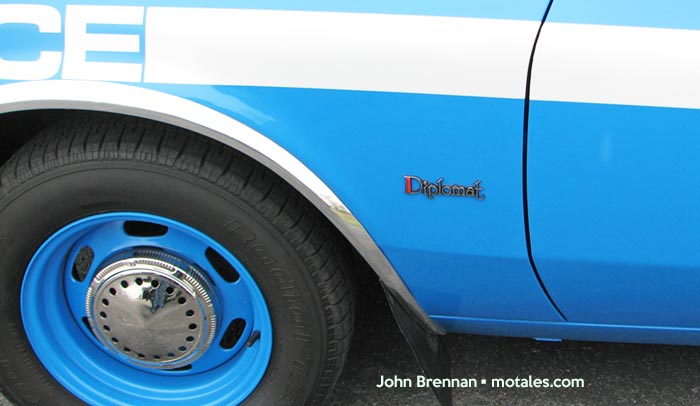
Within a year, the Aspen and Volare spawned more upscale cars—the 1977 Dodge Diplomat, Chrysler LeBaron, and (in Canada only) Plymouth Caravelle. The new cars were coded as “M bodies” while the Aspen/Volare were “F bodies,” but they were similar to the point that the front doors and windshields of the 1978 Aspen would fit onto a 1989 Diplomat. The idea of making economy and “luxury” cars from the same body was not unique; GM had the Chevrolet Nova and Cadillac Seville, while Ford had the Ford Grenada and Lincoln Versailles.
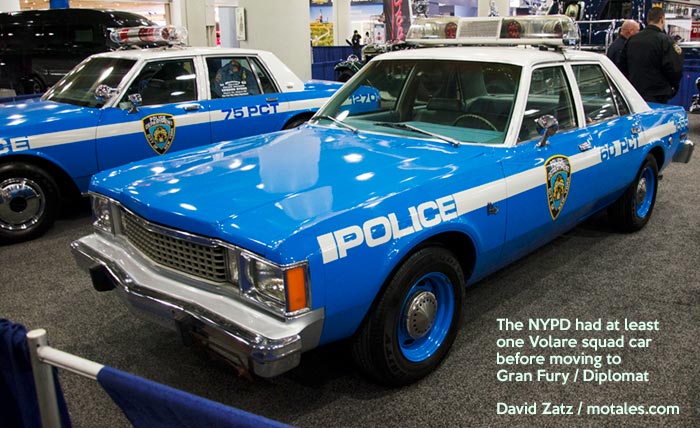
Police versions of the Valiant, Dart, Volare, and Aspen had failed to catch on; but the 1981 Diplomat police package was an immediate success in law enforcement, with the influential California Highway Patrol buying in from the start. Plymouth switched its Gran Fury name from the 1981 R body (which ended production in April 1981) to the 1982 M body and joined Dodge in M-body police-car sales. Developed under fleet engineer Bob Lees, the police package was coded as A38 on 1981-83 cars; and as AHB on 1984-89 cars.
Available engines were a 225 cid (3.7l) slant six and 318 cid (5.2l) V8; there was also a 360 cid V8 into mid-1980, but by the time of the first police package, it was no longer available. Both engines were hooked up to a three-speed automatic. The slant sixes were generally for city or detective use; the slant-six 1981 Diplomat could only do a 21-second zero-to-sixty run, which was quite poor even then, but they did get around 18 mpg, and as officers used to say, “you can’t outrun Motorola” (police radio could summon other officers). The slant six was dropped from passenger cars in 1983, and replaced in trucks at the end of the 1986 model year.
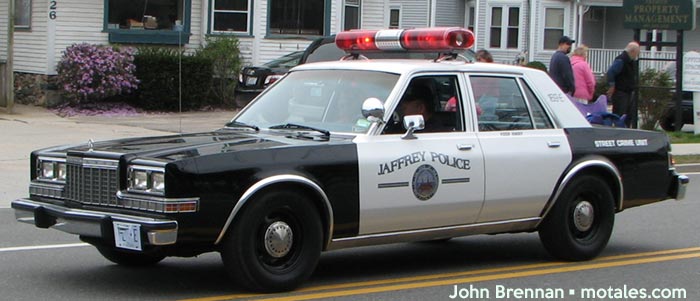
The two-barrel 318 V8 was good for city streets and suburbs, and for ferrying detectives and the brass. A 1984 Diplomat with this engine was clocked by the Michigan State Police at 13.1 seconds to do 0-60 mph, 61 seconds to reach 100 mph, and a 19.5 second quarter mile time.
The top engine, usually specified by state and rural police, was the E48 four-barrel 318 (the codes changed in 1984 to ELD for the two-barrel and ELE for the four-barrel). With this engine, the 1984 Diplomat ran 0-100 mph in 40 seconds, 0-60 in 10.9 seconds, with an 18.2 second quarter-mile time. Some say that the 360 V8 was a police car exclusive in 1982 and 1983, but it doesn’t appear on the police car sales materials; this was likely a mistake based on the 318 using the 360’s head design. Some likely could not believe that a 318-powered car could get up to 122 mph—as it did in the 1986 Dodge Diplomat, in Michigan State Police testing. (That was just 3 mph shy of the Plymouth Fury’s numbers in 1980, with the 360 four-barrel, but under tougher emissions standards.)

The Plymouth Gran Fury and Dodge Diplomat were boxy sedans, dignified, not quite intimidating but certainly maintaining a street presence; the styling was in some ways ideal for police, especially with the upscale trim toned down by chrome removal and lightweight “dog-dish” hubcaps (bearing drilled holes to transmit heat). TV studios kept them going well beyond the time they were retired from active service; and, indeed, the New York City Police Department kept the Gran Fury and Diplomat on the roads for years after they would normally be expected to have retired. That was testament to their quality as police cars, and to their durability.

Civilian versions of the cars had numerous luxury cues, especially in Chrysler form. At their 1977 launch, pricing started at $5,101 for the sedan, compared with $4,317 for an Aspen Special Edition which shared most functional parts. The Diplomat outpriced the bigger Dodge Monaco, and was roughly the same price as the much-bigger Royal Monaco Brougham.
Many styling changes arrived for the 1980 model-year, altering the grille, roofline, trunk lid, and tail; these would be the last major changes, making the car boxier and possibly cheaper to build. The 1981 Diplomats had a moderately different grille and a plainer, cheaper grille on every trim level—handy for its first year with a police package. The Aspen and Volare were made mainly at Dodge Main; the Diplomat, Gran Fury, and other M-bodies were mainly made at Windsor until the end of 1983, when they moved to Fenton (St. Louis) to make room for the minivans. Ironically, that plant would also switch to minivans, sending the M-bodies to an AMC factory in Kenosha from March 1987 till their end.
The Chrysler and Dodge had the same headlight assembly, only the Chrysler’s was below the parking lights and the Dodge’s was above them. Among non-police buyers, the Chrysler versions of the M-bodies were far more popular than the Dodge or Plymouth—selling more than the two “lesser” brands combined. The 1980-83 “J body” Dodge Mirada and Chrysler Cordoba and 1981-83 Chrysler Imperial were similar to the M bodies, but dubbed J bodies since the windshield was at a steeper angle—making the platform different, by the company’s definition.
What did the police packages include, one may ask? In essence, they upgraded the cars to handle and stop better and to last longer, while taking off extra chrome trim and visible luxury cues. In terms of engines, there were numerous durability upgrades as well as a severe service testing schedule:
In addition to the durability upgrades, the 318 four-barrels gained many of the performance features of the former 360 four-barrel engines, which were not used in cars after 1980. This included the 340/360 high-performance 597 casting heads until 1983; and the new 345 casting with larger coolant jackets from 1984 to 1989. These heads may have caused some to think they had a 360 engine... but they didn’t. They did have the 360 heads, intake manifolds, exhaust manifoldsm, and camshafts which pump the output of the 318 4 barrel engine to nearly the 360’s output. Ed Poplawski noted that “There was talk of using the W-2 heads from Mopar performance but that died a quick death because of production capacity and what line to make them on.”
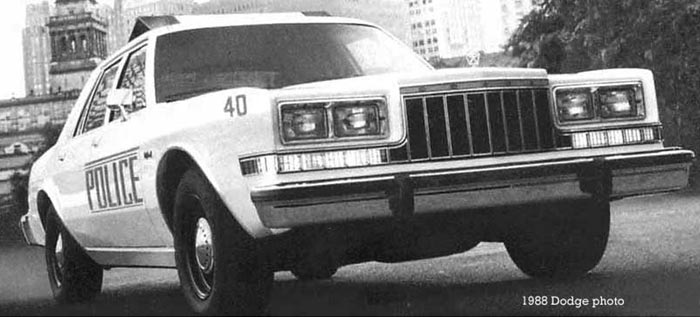
The early four-barrel carburetors, Carter Thermoquads, could be fussy; and their fast-idle cams, made of pot metal, and accelerator pumps could wear out quickly.
In 1983, all slant six cars had standard feedback carburetors (using oxygen sensors) and electronic spark control (Lean Burn), which were only on some of the 1982s.
For 1985, the two-barrel cars switched to the Holley 6280 (2280 in Canada) carburetor after Carter ended production; the 6280 was an electronic feedback version, which replaced the 2280 in Canada in 1988. Chrysler also moved to new 302 “swirl port” heads and hydraulic roller lifters on both two and four barrel engines. The four-barrel switched over to a Rochester (GM) Quadrajet carburetor. The Quadrajets carburetors were aprt 4306411 from 1986-87 and 4306433 from 1985-89, depending on usage—the latter was an electronic feedback version. Trucks had different versions of the same carburetor; the 4306411 was the same as the GM 17085411, and the 4306433 was the same as GM 17085433.
Regardless of engine, the A38 and AHB package cars themselves had normal police-car upgrades; front disc brakes and bigger rear drum brakes; perforated “dog-dish” hubcaps to release more heat; and power steering fluid coolers (V8s only).
Fleet engineer Bob Lees said, “The police are like greyhounds at a rabbit track, when they see somebody doing something wrong they have complete focus on them and they take off after them. They don’t care if they are jumping curbs, or going over ditches or through hedges, they want to catch that person, so you do a lot to reinforce the suspension. You do things to the engine to make it last longer, and handle high speed work.”
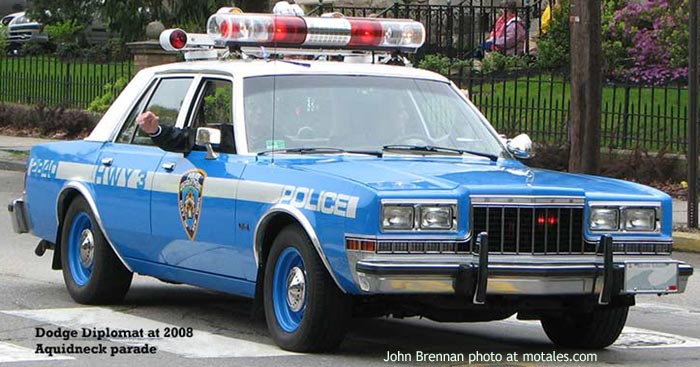
Later two-barrel 318 M-bodies had economy axle ratios (2.24:1), cutting acceleration and top-end speeds unless departments specified the 2.94:1 ratio (which was standard in all four-barrel M-body police cars). The economy axle resulted in two-barrel V8 powered police cars accelerating in the same time as four-cylinder Plymouth Reliants (which were available to the police as “scout cars”). The axle itself was the durable 8.25” design.
The heavy duty suspensions were tuned for cornering and durability, at the expense of comfort. A Chrysler Fifth Avenue had a decent, even cushy, ride (for the time); but a police Diplomat or Gran Fury did not. They were firm to the point of jiggliness, a characteristic modern police cars still have. Despite this, the police gave them fairly high ratings in a later survey.

All M-body cars had an Aspen-Volare type transverse torsion bar front suspension, with the bar anchor near the control arm on the opposite side; the idea was to combine a “big car ride” with enough room for emissions gear. Oddly enough, the alignment specs for the M body was different from those for the F-body, suggesting some sort of subtle change (or just, perhaps, a different set of people).
All the police cars had standard front and rear sway bars; the civilian versions had standard front sway bars. The rear suspension was also taken from the Volare and Aspen, not surprisingly, and used Chrysler’s usual design with long front sections on the leaf springs so that under heavy acceleration the rear would squat down and provide more traction. The transverse torsion bars up front were often criticized, but tended to ride and handle well if maintained properly and kept at the proper ride height.
Police cars had 11-inch front discs and 11-inch rear drums, with 15 inch wheels. Power steering and power brakes started as options and later became standard.

Through the end of the 1983 model-year, police cars had the A-727 (36RH) transmission with lockup torque converters; starting with the 1984s, police cars switched to the A-904 (32RH), though taxis may have kept the A-727. In 1988, two-barrel cars switched to the A998 transmission (later coded 31RH), while four-barrels had the A999 (32RH); the main difference was a thicker clutch pack in the A999. Both were based on the A-904.
In 1985, before Chrysler acquired AMC, they contracted to build the M-bodies in AMC’s Kenosha factory, agreeing with AMC and the unions to make the cars into 1992. The move was needed to convert the Fenton plant to minivans, which were hot sellers at that point. The 1986 and early 1987 M-bodies were still made in Fenton.
The 1986 models were similar, but police cars had new computer calibrations which woke up both engine configurations; and a third brake light. Retail models were lumbered with a gas-guzzler tax.
New SCC calibrations disqualified the 1987 Diplomat four-barrel from a 0-80 mph run at the Michigan State Police tests; but the Plymouth Gran Fury easily passed the tests. Other changes were using welded stainless steel exhausts instead of clamped pipes, and a new “luxury” steering wheel.
In March 1987, AMC’s Kenosha assembly plant started making the Diplomat, Gran Fury, and Fifth Avenue, which had to move from Fenton to make away for expanded minivan production. At the same time, they went to galvanized or stainless steel where there was any chance of contact with the elements; and the interiors were toned down, with lower grade carpet and unchromed dashes. To compensate for that, they gained standard power mirrors and AM stereo/FM stereo radios; midyear, power locks and windows were also made standard, with optional cassette players, and new standard driver’s-side airbags. Tougher K-frames were set up as a running change.
In early 1988, Lee Iacocca announced his decision to shut down the M-bodies and close Kenosha in June 1988. Since this went against the union agreements, there was a bit of a fight, resulting in Chrysler paying penalties and keeping production going through the end of the year—which meant there would be a short-run 1989 model. As one would expect, there were no changes to the ’99s.
Three issues were dealt with in 1986:
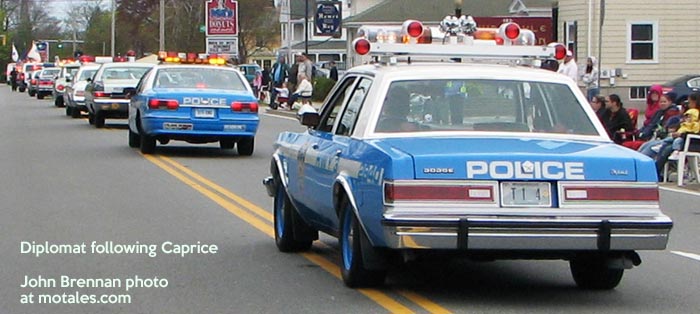
One of the problems endemic to these cars was failure of the suspension towers, worsened by K-member issues. The cure was expensive: replacing the K-member and shock towers. Local road quality was a major factor, so a New York City car might be in the shop fairly quickly while the Montana state police might, like retail models, never see a problem. A fix was put into production in May 1988.
The K-frame issue was rare until early 1985, suggesting a manufacturing problem caused by the switch from the Windsor plant to Fenton, possibly due to a new vendor or plant making the K-frames. M-bodies made in Kenosha used K-frames from A.O. Smith of Milwaukee, and the problems disappeared in mid-1988. The K-frame would usually split at the pinch welds when it failed, so mechanics put clips over the cracks or splits and welded it back together, with a plate at the bottom of the cradle to stiffen it up.
Former officer and fleet manager Curtis Redgap wrote that the Diplomat and Gran Fury were better police packages than the Impala and Crown Victoria (“Police Interceptor” in Ford terms) in nearly every metric until the 1989 Caprice arrived. Compared to the R-bodies, they were more reliable, cornered better, and were smaller on the outside but about the same size inside.
GM’s new, fuel-injected 1989 Caprice turned the tables, beating the old Dodge and Plymouth in every category but braking and egonomics. The Caprice still had Diplomat-like looks, too, until the 1991s. Chrysler had a fuel-injected 318 already, but it was only used for trucks, and the reasons for closing M-body production rather than modernizing the engines and keeping them on until 1992—avoiding contract penalties—is known only to Lee Iacocca. It would have made for a more dramatic entrance for the LH cars and kept Chrysler dominating fleet sales for a while longer.
 Dodge Intrepid: the police car
Dodge Intrepid: the police car
Agile, surprisingly quick front while drive pursuit vehicles
 Plymouth police cars of 1976
Plymouth police cars of 1976
Downsized but strong
 Car Spotter: 1971 Plymouth Fury Pursuit Car
Car Spotter: 1971 Plymouth Fury Pursuit Car
Big and classy police car
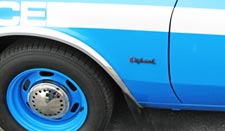 Making police cars: who and what was involved?
Making police cars: who and what was involved?
Diving into the changes that make an ordinary car into a pursuit vehicle (or just an ordinary police car)
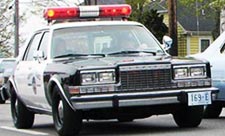 Prototypical police cars: Dodge Diplomat and Plymouth Gran Fury
Prototypical police cars: Dodge Diplomat and Plymouth Gran Fury
Inside the M-body Dodge Diplomat and Plymouth Gran Fury that defined how police cars should look for at least a decade
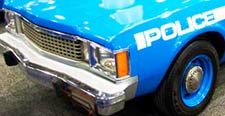 Mopar police cars of 1980: St. Regis/Gran Fury, Aspen/Volare, B-Van
Mopar police cars of 1980: St. Regis/Gran Fury, Aspen/Volare, B-Van
The last of the big Plymouth and Dodge police cars, in their penultimate year, with the final F-body squads
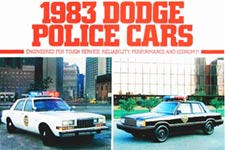 Mopar police cars of 1983: Diplomat/Gran Fury and Reliant/Aries
Mopar police cars of 1983: Diplomat/Gran Fury and Reliant/Aries
Two quite different approaches to police cars, with front and rear wheel drive, powered by V8 and four-cylinder engines
Books by MoTales writer David Zatz
Copyright © 2021-2024 Zatz LLC • Chrysler / Mopar car stories and history.